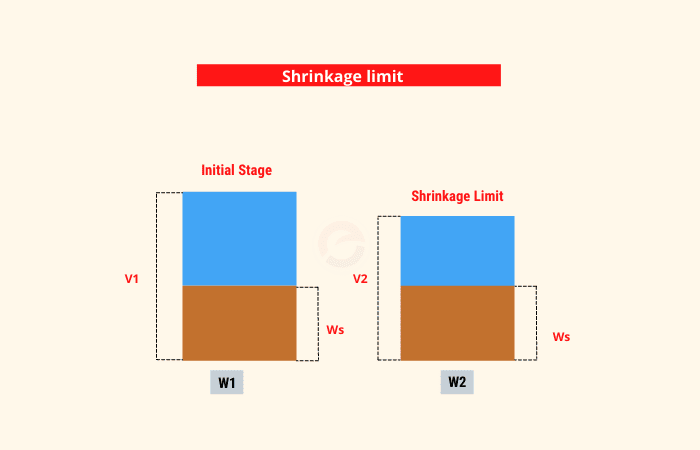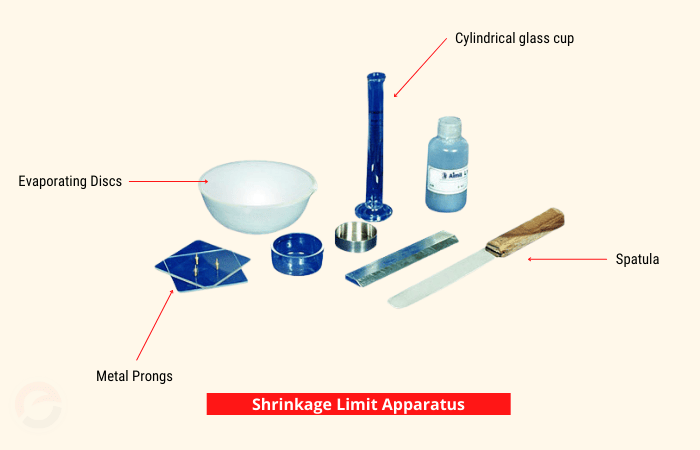Shrinkage limit of soil
When moisture is gradually decreased from the soil it shrinks. The shrinkage stops with no further volume change when an equilibrium is reached and that stage is called shrinkage limit. The water content below which a reduction in water content does not result in a decrease in the volume of the soil mass is known as the shrinkage limit. It’s also the lowest point at which the soil becomes saturated.

Shrinkage limit test
Take a round shrinkage dish with a diameter of 30 mm to 40 mm and a height of 15 mm, manufactured of porcelain or stainless steel. The dish has rounded internal corners and a flat bottom. At first, the dish is filled with mercury to find out its capacity.
The shrinkage dish is placed in a big porcelain evaporating dish after the mercury is poured in and then squeezed with a simple glass plate to extract the excess mercury. The capacity of the shrinkage dish is calculated by dividing the mass of mercury in grams by the specific gravity of mercury. The inside of the empty shrinkage dish is covered with Vaseline or silicone grease.

After that, around one-third of the soil sample is placed in the shrinkage dish. The dish is tapped on a firm surface to release the trapped air. Continue tapping until the dirt in the dish is filled. A straight edge is used to remove the excess soil from the top surface by striking it off. The mass (M1) of the soil is then calculated using the mass of the shrinkage dish containing soil. The capacity of the shrinkage dish is equal to the volume of the soil V1.
The soil pat in the shrinkage dish is allowed to dry in the air until it turns light in color. After that, it’s dried in an oven, and the dry soil mass is calculated as M2. To calculate the volume of the dry pat, in a huge dish, a glass cup with a diameter of 50mm and a height of 25mm is placed.
The cup is then filled with mercury, and the excess is removed by pushing a three-prong glass plate firmly over the top of the cup. The mercury-filled cup is transferred to a new dish. The dried part of the soil is withdrawn from the shrinkage dish and placed on the surface of the mercury in the cup, then pressed into it with the prongs of a glass plate.
In a mercury weighing dish, the mercury that has been displaced by the dirt pat is weighed. The mass and specific gravity of mercury are used to compute the volume of mercury. The dry pat Vd is equal to V2, and the volume of mercury displaced is equal to V2. The shrinkage limit of soil is determined using the equation,
${{W}_{S}}=\frac{({{M}_{1}}-{{M}_{2}})-({{V}_{1}}-{{V}_{2}}){{\rho }_{w}}}{{{M}_{2}}}$
From the measured V1, V2, M1, and M2.
Shrinkage limit apparatus
The apparatus used in the shrinkage limit tests are a Shrinkage limit dish, a glass cup, a glass plate with prongs, a porcelain evaporating dish, a spatula, a plastic squeeze bottle with water, Mercury, watch glass, steel straight edge.

Shrinkage limit of soil formula
The shrinkage limit of soil is calculated by the formula:
${{W}_{S}}=\frac{({{M}_{1}}-{{M}_{2}})-({{V}_{1}}-{{V}_{2}}){{\rho }_{w}}}{{{M}_{2}}}$
M1 = mass of shrinkage dish with soil
M2 = mass of shrinkage dish filled with dry soil
V1 = volume of soil
V2 =Volume of mercury displaced
Also Read: Major types of soil
Degree of saturation at shrinkage limit
There is a 100% saturation level at the shrinkage limit of soil.
What is the liquid limit of soil?
The point at which the soil transforms from a liquid to a plastic state is known as the liquid limit of the soil. In other words, with the current moisture content, the liquid limit is the moisture content required to close a gap of 12.7 mm at the groove’s bottom after 25 blows. To determine a soil’s liquid limit, the Casagrande Liquid Device is utilized.
What is the plastic limit of soil?
The plastic limit of soil is the moisture content where the soil converts from such a plastic state to a semi-solid state and also crumbles when rolled into 4.2mm diameter threads. The plastic limit refers to the lowest point in the plastic stage of the soil. A soil mass is molded into an ellipsoidal-sized mass of soil on a ground glass surface to test the plastic limit.
Difference between plastic limit and shrinkage limit
| Plastic Limit |
Shrinkage Limit |
| The plastic limit is the water content where the soil converts from such a plastic state to something like a semi-solid condition. | Shrinkage limit refers to the point in the soil’s water content where the further loss of moisture doesn’t lead to a reduction in the sample volume. |
| Samples are rolled into a thread indefinitely until it reaches a point where it crumbles. | In a specific shrinkage dish, samples are molded into a soil pat of the moist test material. |
| Glass plate and plastic limit apparatus are among the apparatus employed. | Vaseline, shrinkage limit equipment, shrinkage dish, glass plate are the apparatus used for the test. |
Also Read: Unit Weight of Soil
Relation between liquid limit plastic limit and shrinkage limit
The graph below depicts the transformation of soil from a solid to a liquid condition as its water content fluctuates. The Atterberg limits are the water content that corresponds to each state transition. The liquid limit (WL) is the point at which the soil transitions from a liquid state to a plastic state. At this point, all soils have a tiny amount of shear strength.
The plastic limit (WP) is the water content where the soil converts from such a plastic state to something like a semi-solid state. The shrinkage limit is reached when the water content of the soil is reduced to the point where the volume cannot be reduced any further (WS). A soil’s plasticity index (IP) is the range of water content between the liquid and plastic limits, as computed by the equation below.
$I{}_{P}={{W}_{L}}-{{W}_{P}}$
Frequently Asked Question and Answers
At shrinkage limit, the degree of saturation is
100 %
The shrinkage limit is code
IS-2720-PART-6-1972
In shrinkage limit, the volume of soil is
not decreased when the water content is reduced below the shrinkage limit
The density of water used in the shrinkage limit test is
1 gm/cm3
How to find a shrinkage limit?
The shrinkage limit test is used to find the shrinkage limit in a laboratory.


Shrinkage limits define the point where soil stops shrinking as it dries. It helps engineers understand soil behavior in construction. Accurate calculations prevent structural issues and foundation cracks. A small formula, but a big key to stability.